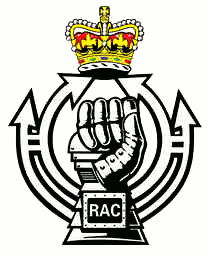
The Royal Armoured Corps is the component of the British Army, that together with the Household Cavalry provides its armour capability, with vehicles such as the Challenger 2 Tank and the Scimitar Reconnaissance Vehicle. It includes most of the Army's armoured regiments, both the Royal Tank Regiment and those converted from old horse cavalry regiments. Today it comprises twelve regiments, eight regular and four reserve. Although the Household Cavalry Regiment provide an armoured regiment, they are not part of the RAC.
A division is a large military unit or formation, usually consisting of between 6,000 and 25,000 soldiers.

A brigade is a major tactical military formation that typically comprises three to six battalions plus supporting elements. It is roughly equivalent to an enlarged or reinforced regiment. Two or more brigades may constitute a division.
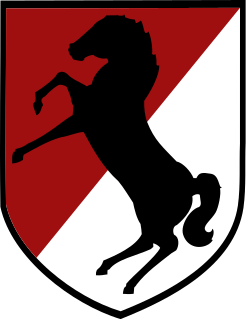
The 11th Armored Cavalry Regiment is a unit of the United States Army garrisoned at the Fort Irwin National Training Center in California. Although termed an armored cavalry regiment, it is being re-organized as a multi-component heavy brigade combat team. The regiment has served in the Philippine–American War, the Pancho Villa Expedition, World War II, the Vietnam War, Gulf War and Iraq War. The 11th ACR serves as the opposing force (OPFOR) for the Army and Marine task forces, and foreign military forces that train at Fort Irwin.
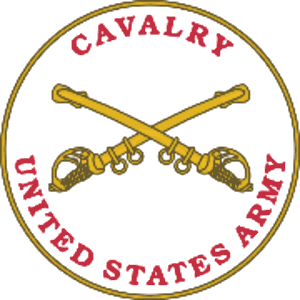
The United States Cavalry, or U.S. Cavalry, was the designation of the mounted force of the United States Army by an act of Congress on 3 August 1861. This act converted the U.S. Army's two regiments of dragoons, one regiment of mounted riflemen, and two regiments of cavalry into one branch of service. The cavalry branch transitioned to the Armored Forces with tanks in 1940, but the term "cavalry", e.g. "armored cavalry", remains in use in the U.S. Army for mounted reconnaissance, surveillance, and target acquisition (RSTA) units based on their parent Combat Arms Regimental System (CARS) regiment. Cavalry is also used in the name of the 1st Cavalry Division for heraldic/lineage/historical purposes. Some combined arms battalions are designated as armor formations, while others are designated as infantry organizations. These "branch" designations are again, heraldic/lineage/historical titles derived from the CARS regiments to which the battalions are assigned.

The 2nd Armoured Division was an armoured formation of the Australian Army during World War II. Originally raised in 1921 as the 2nd Cavalry Division, based in Victoria and South Australia, the formation had been converted into a motor division in early 1942, before adopting the armoured designation later in the year. A Militia formation, the division undertook garrison duties in Australia and did not see combat before being disbanded in mid-1943.

The 3rd Armoured Division was an armoured unit of the Australian Army during World War II. Originally raised in 1921 as the 1st Cavalry Division, the formation had been converted into a motor division in early 1942, before adopting the armoured designation in November 1942. A Militia formation, the division undertook garrison duties in New South Wales and then Queensland and did not see combat before being disbanded in late 1943 and early 1944.

The 2nd Cavalry Division was a cavalry division of the United States Army.
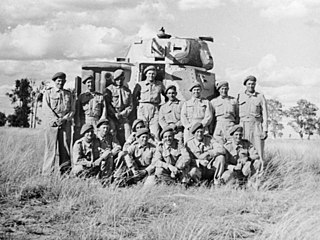
Armoured units made a relatively small, but important, contribution to Australia’s war effort during World War II. While Australia formed three armoured divisions and two independent armoured brigades during the war, Australian armoured units only saw action as independent regiments and companies supporting larger infantry formations. Early actions were fought in the Middle East by the divisional carrier regiments that supported the 6th, 7th and 9th Divisions, fighting in Libya, Egypt and Syria in 1941–42, before the Australian divisions returned to Australia in 1942–43. During the early fighting in the Pacific, there was a limited role for armoured formations, although one armoured regiment – the 2/6th – took part in the fighting around Buna–Gona in late 1942. Later in the war, though, during the Huon Peninsula, Bougainville and Borneo campaigns of 1943–45, several armoured units were used by Australian forces in the infantry support role.

The 199th Infantry Brigade (Light) is a unit of the United States Army which served in the Army Reserve from 1921 to 1940, in the active army from 1966 to 1970, briefly in 1991–1992 at Fort Lewis, and from 2007 as an active army training formation at Fort Benning.
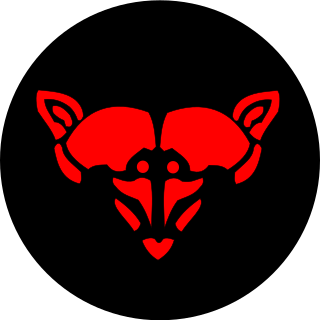
The 10th Armoured Division was an armoured formation of division-size of the British Army, raised during the Second World War and was active from 1941–1944 and after the war from 1956–1957. It was formed from the 1st Cavalry Division, a 1st Line Yeomanry unit of the Territorial Army (TA) which had previously been serving in Palestine. The division was converted from cavalry to armour and redesignated from 1 August 1941.

Nikolai Ivanovich Gusev was a Soviet Army colonel general.
The 23rd Cavalry Division was a cavalry formation of the United States Army National Guard during the interwar period.
The 101st Rifle Division was a unit of the Soviet Red Army initially formed as a mountain rifle division on 28 August 1938 within the 2nd Separate Red Banner Army in Petropavlovsk-Kamchatsky city.
The cavalry division of the Soviet Union's Red Army was a type of military formation that existed from the early days of the Russian Civil War until the early 1950s when they became obsolete with the rise of mechanized warfare.

Two years after the end of the Estonian War of Independence (1918-1920), the Estonian Army consisted of 3 field divisions and a number of small independent battalions and companies (1922).

The 2nd Armoured Brigade was a formation of the Australian Army during World War II. The brigade was formed in July 1941, at Puckapunyal, Victoria, from Second Australian Imperial Force volunteers. It was assigned to the 1st Armoured Division in July 1941, with the intention of deploying it to the Middle East. However, it was reassigned to home defence following Japan's entry into the war, and was then transferred to the 3rd Armoured Division in October 1942. The brigade remained in Australia, undertaking defensive duties in Victoria and Queensland before being disbanded in January 1944. While it did not see any active service as a formation, some of its constituent units eventually took part in the campaigns on Tarakan, Labuan, Bougainville and around Aitape–Wewak in 1944–1945 after transferring to other brigades.
The 75th Cavalry Division was a cavalry formation of the Red Army which fought during World War II.
The 105th Cavalry Regiment is a regiment in the United States Army National Guard.

The 5th Guards Cavalry Division was a military unit in the Workers' and Peasants' Red Army of the Union of Soviet Socialist Republics in the Great Patriotic War.













